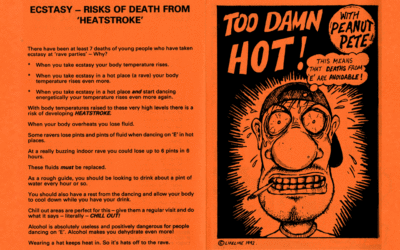First it was cigarettes, then came vapes, but what’s the deal with the newest nicotine product?
If you have managed to go to a bar recently and avoided coming into contact with hockey puck sized cylinders or haven’t heard the phrase “popping an upper-decky” – maybe you should get out more. These nicotine pouches, a riff on the traditional Swedish snus, are the country’s newest favourite way of putting nicotine into our bodies. But what are they, what happens if you use them and is this a ‘least worst option’ for satisfying cravings?
Google “what are nicotine pouches?” and the first result is an advert from Nordic Spirit offering you a free sample. Nordic Spirit is one of the two main brands of nicotine pouch currently dominating the UK market. They offer stylish Scandinavian looking containers (commonly known as cans) and flavours like spearmint, elderflower and watermelon. Whatever you google about nicotine pouches, adverts for the products themselves will be holding their own amongst the medical advice and press commentary.
We wanted to hear some real life stories so we talked to Alex and Charlie*, two connoisseurs of the nicotine pouch, with two very different experiences.
Alex is a 20 year old student at the University of Glasgow and has been using nicotine pouches for around two and a half years.
So Alex, first of all, I’m confused, what is the difference between nicotine pouches and snus?
“The pouches you get in the UK are white snus, the difference is the traditional ones have actual tobacco in them. They don’t taste nice at all, only of tobacco. I only do white snus and the Scandi guys our age seem to also only use white snus too”
What was your first time trying nicotine pouches, was it love at first rush?
“I had my first experience with it in 2020 at a festival when they were handing out free ones. I was definitely sick, throwing up. Pretty much the same as everyone their first time.”
Then how did you get so attached to them?
“I lived in Switzerland for a while and there’s a lot of Swedish and Danish people there so snus was pretty big there so I picked it up.
”The Swedes and the Danish people absolutely love snus. The toilets there, if you went to the urinals, they would just be full of snus. It’s everywhere. It’s just quite nice, and it’s better than smoking to get, like, a nicotine rush. That’s what’s nice about them.
”I’ve heard of old Swedish people, though, who now have holes in their gums, but I think that’s only because they use the old tobacco versions. I definitely think the new white snus is better than the old one.”
Since moving back to the UK have you kept up with the amount you used to use in Switzerland?
“I’m probably down to about one can per week now but at my peak it was probably three cans per week. There’s usually around 21 – 24 snus in a can so I was probably having upwards of ten to thirteen a day. At the peak the strength was probably 21mg.
“I have cut the mg I use down to 17mg, which is the max you can legally buy in England but even round Glasgow you can buy 150mg snus from corner shops.
“But the strongest I’ve ever tried is a 56mg one. That was the third ever time I’d tried it. I was in Bratislava and this random guy gave it to me and I just started throwing up in the toilet. I was bedridden.”
To be honest, I’m still struggling to see the appeal, why do you use something that seems mainly to make you ill?
“I think when you use snus and your body has got used to it, it relaxes you. So I can work more.
“A lot of people my age will use them. If you’re going to do an essay, they’ll pop one in or use them during sport. I use them when I play football.
“If I could go back in time and choose not to be addicted to nicotine pouches? I reckon I still would. I’ve seen quite a lot of benefits from it. Like increased efficiency when working and focus. Obviously better than smoking, so I’ve reduced the amount I smoke.”
Why have you cut back then?
“I’ve cut back my usage, because I don’t want to be doing it a lot anymore. Just having to carry them around all the time. And for cost reasons. Even if they are quite cheap, it does add up once you’re spending, £20 a week.
“I always ask my dentist what my gums look like because I do snus and he says they’re fine. To be honest I haven’t really seen any negative effects from it.”
A glowing endorsement there from Alex, but what about Charlie, is he on the nicotine hype train too?
Charlie is a 21 year old student at the University of Sheffield who used nicotine pouches for about three months.
Now Charlie, your experience is quite different to Alex’s, can you tell us about your first time trying nicotine pouches?
“My first experience of them came last summer. I was in the airport about to go on holiday with my friends when someone offered them round. I’m quite a heavy smoker so thought ‘what the heck’ and took one. After five minutes, I had to go and sit in the bathroom because I felt so sick. I was there for ten minutes just hunched over the toilet trying not to chun.”
Your first experience seems to be wholly negative, how did you get into using them?
“Over Christmas I decided to try to quit smoking and someone recommended nicotine pouches as a good way to quit. I started to use them more and got used to the amount of nicotine in each one so I didn’t feel sick every time I used them. It got to the point where I was using them more often than I would smoke. Maybe five or six a day.
“I started off with the 3mg ones but by the end I was having 17mg of nicotine per pouch. It was really severe.”
One of the draws of these pouches is that people say they can help you quit smoking. Did you find that?
“The problem was that I would smoke at the same time. I was trying to quit smoking but I think the thing that really kept me addicted was the physical action of rolling a fag. So if I was ever in the pub or something, there would be times when I’d have a 17mg snus in whilst having a cigarette at the same time.
“It did cut the craving for nicotine down but it didn’t help me properly quit.”
Did you notice any negative effects?
“I would bleed aggressively every time I did my teeth. My gum felt like it was receding back up my teeth. I know I smoke but I started to feel unfit and tired. I would swear sometimes I could feel pieces of my gum rotting and sensitive. Sometimes when I put the heavier ones in, if I hadn’t eaten enough in the day I would have to lie down for half an hour just feeling ill. But I would still keep it in.
“My teeth, even now, months after stopping, still feel, like, decrepit and they still bleed occasionally.”
Could you find any positives in the time you were using nicotine pouches?
“No. And I’ve gone back to smoking.”
These examples show us how different the use of nicotine pouches can be for different people. I still wanted to know more, so, as we do here at Messy, we turned to an expert.
Dr Rosemary Hiscock is a research associate at the Tobacco Research Group at the University of Bath. She is currently working on a project called STOP, a tobacco watchdog.
Dr Hiscock, why have these products become so popular?
“The tobacco market is in a decline and is forecast to continue declining. The big tobacco companies are trying to keep up their profitability, so are looking at newer products.”
What are the potential risks of using nicotine pouches/snus?
“We have, on the Tobacco Tactics webpage, a list of the health effects of snus that have been documented, including cardiovascular disease, high blood pressure, heart attacks, strokes and types of cancer. One of the main problems of snus is that it can be used with other products. People might use snus and still smoke cigarettes, so it’s quite difficult to untangle what is snus and what is people still using cigarettes as well.
“It can become more of a supplement to the cigarettes than a replacement for them.”
So you wouldn’t recommend snus/nicotine pouches as a way to quit smoking?
“I think the general tobacco control community would say that it’s best to use evidence-based methods for quitting. Like behavioural support, various pharmacotherapies that you can use, like varenicline or champix.”
The smoking rate in Sweden is only 6% and they attribute that to their use of snus…
“Snus has been a traditional thing in Sweden, whereas in other countries you have had the market for cigarettes and not for snus so bringing it in here as a new product would be different to what has happened in Sweden.”
Just like disposable vapes, little is known of the long term effects of nicotine pouches, they might be the next big thing, they might be your dentist’s worst nightmare so make your own minds up guys. As for me…if they made a kebab flavoured one…
*name has been changed to protect privacy
Sidebar: According to Healthline the average milligrams of nicotine in a cigarette is 10 – 12.
Sidebar: pharmacotherapy is the treatment of health conditions using pharmaceutical products as medicine, according to the Alcohol and Drug Foundation.

Read more here
Wtf is ‘gut health’ and how do I keep up with it?
Gut health is the bogey man on social media. Every health influencer is talking about it and every supplement is needed to help it. But how important really is your gut health? And how can you really help it? Shelley Balls, a licensed dietitian and owner of Fuelling…
Swapping paranoia for preventative care: How to look after your health
In 2024, our health is coming first and that includes check ups and preventative care. Prioritising your health in your 20s lays the foundation for a healthier future. Alcohol A common form of preventative care that people tend to forget is alcohol and other…
The importance of harm reduction: How to look after yourself and your friends when it comes to drugs
For a lot of people in their twenties, Friday nights will be spent tearing up the dance floor in their dingy local club and summers will be spent in a (muddy) field, overpriced pint in hand, enjoying a festival main stage. But, something else that is synonymous with…




